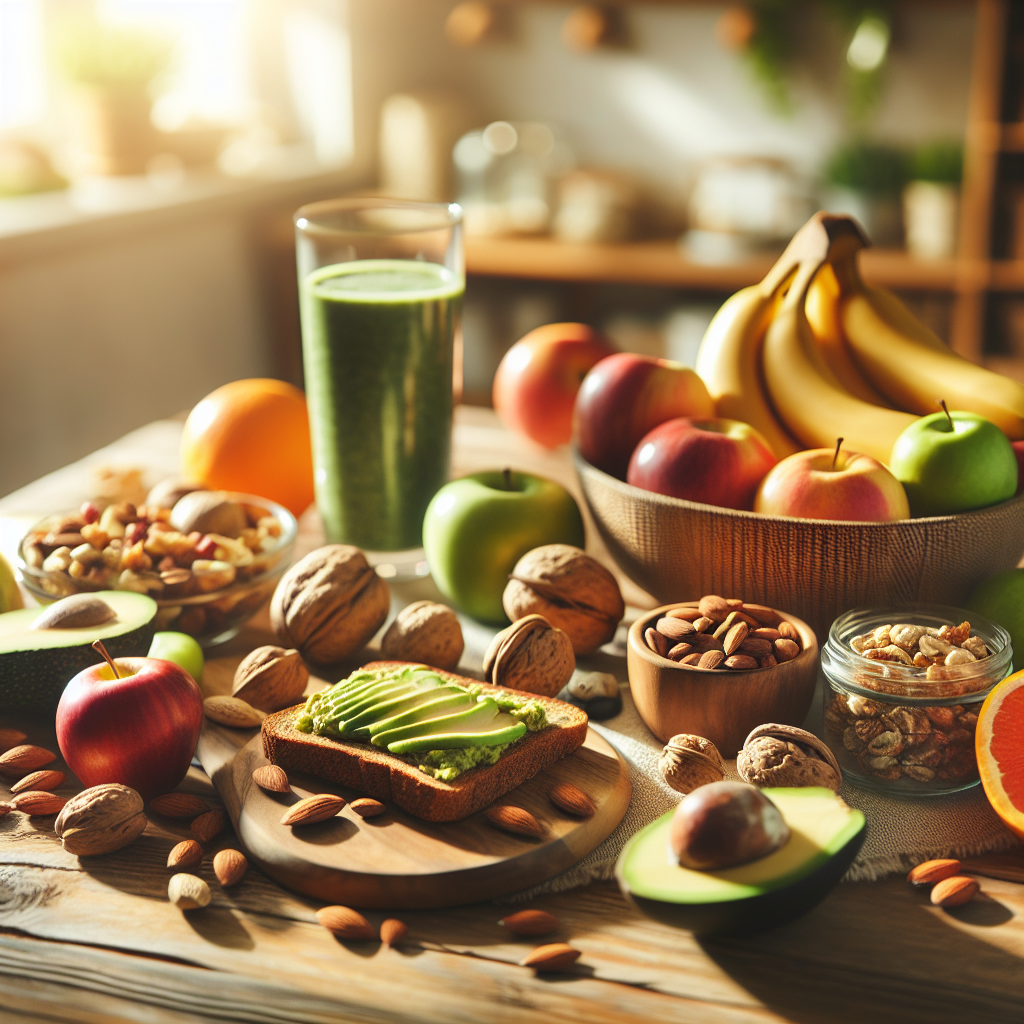
Top Energizing Foods for Boosted Vitality and Stamina
In our fast-paced world, maintaining high energy levels throughout the day can feel like an uphill battle. Whether you’re facing an afternoon slump at work, struggling to power through your workout, or simply feeling drained by daily responsibilities, what you eat plays a crucial role in your energy levels. The right foods can provide sustained vitality, while poor dietary choices can leave you feeling sluggish and fatigued.
Nutrition experts consistently emphasize that energy doesn’t come from a can or bottle of sugary energy drinks—it comes from wholesome, nutrient-dense foods that fuel your body effectively. Let’s explore the science-backed foods that can naturally boost your energy levels and help you maintain stamina throughout your busy day.
Understanding Energy from Food: The Science Behind Vitality
Before diving into specific foods, it’s important to understand how our bodies convert what we eat into energy. Our primary source of energy comes from calories in food, particularly from three macronutrients: carbohydrates, proteins, and fats.
Carbohydrates break down into glucose, which is your body’s preferred fuel source. Proteins provide amino acids necessary for muscle repair and enzyme production, while healthy fats provide concentrated energy and support vital functions. The key is choosing nutrient-dense versions of these macronutrients that provide sustained energy rather than quick spikes followed by crashes.
Complex Carbohydrates: The Steady Energy Providers
Complex carbohydrates are the cornerstone of sustained energy. Unlike their simple counterparts that cause blood sugar spikes and crashes, complex carbs break down gradually, providing a steady stream of glucose to power your body and brain.
Whole Grains: The Foundation of Lasting Energy
Whole grains contain the entire grain kernel—the bran, germ, and endosperm—providing fiber, vitamins, and minerals that refined grains lack. This nutritional profile helps stabilize blood sugar levels and provides sustained energy.
- Oatmeal: Rich in soluble fiber, oats digest slowly and provide steady energy for hours. Steel-cut and rolled oats have a lower glycemic index than instant varieties, making them ideal for sustained energy.
- Quinoa: This complete protein source contains all nine essential amino acids along with complex carbs, making it an exceptional energy-boosting food that supports muscle function.
- Brown rice: With its fiber-rich bran layer intact, brown rice provides B vitamins essential for energy metabolism along with steady-releasing carbohydrates.
- Barley: This ancient grain contains beta-glucan, a special type of fiber that helps maintain stable blood sugar levels while providing lasting energy.
Starchy Vegetables: Nature’s Energy Powerhouses
Starchy vegetables offer complex carbohydrates paired with fiber, vitamins, and minerals, creating a perfect combination for sustained energy without blood sugar spikes.
- Sweet potatoes: Packed with complex carbs, fiber, and beta-carotene, sweet potatoes provide long-lasting energy while supporting immune function.
- Butternut squash: This fall vegetable offers vitamin A, potassium, and complex carbohydrates that digest slowly for extended energy release.
- Beans and lentils: These plant-based powerhouses combine complex carbs with protein and fiber, creating a triple threat for sustained energy that prevents mid-day crashes.
Protein-Rich Foods: Sustaining Energy and Building Strength
Protein is essential for stabilizing blood sugar, repairing tissues, and maintaining energy levels. It takes longer to digest than carbohydrates, helping to provide lasting satiety and preventing energy crashes.
Lean Animal Proteins
- Eggs: Considered nutritional powerhouses, eggs contain high-quality protein, B vitamins, and choline that support energy production at the cellular level. The complete amino acid profile makes them particularly effective for sustained energy.
- Greek yogurt: With twice the protein of regular yogurt and probiotics that support gut health, Greek yogurt provides lasting energy while potentially improving nutrient absorption.
- Lean poultry: Chicken and turkey provide complete proteins with lower fat content than red meat, along with energizing B vitamins that help convert food into usable energy.
- Fatty fish: Salmon, mackerel, and sardines combine protein with omega-3 fatty acids that fight inflammation and support brain function, helping you stay mentally sharp while maintaining physical energy.
Plant-Based Proteins
- Legumes: Chickpeas, black beans, and lentils combine protein with fiber and complex carbs, creating a trifecta for sustained energy that prevents blood sugar fluctuations.
- Nuts and seeds: Almonds, walnuts, chia seeds, and flaxseeds provide protein, healthy fats, and fiber that work together to sustain energy levels while supporting heart health.
- Tofu and tempeh: These complete plant proteins contain all essential amino acids along with minerals like iron and magnesium that play crucial roles in energy production.
Healthy Fats: The Concentrated Energy Source
Despite years of misguided low-fat diet trends, healthy fats are essential for sustained energy. They provide more than twice the calories per gram compared to carbs and proteins, making them an efficient fuel source, especially for endurance activities.
- Avocados: Rich in monounsaturated fats and fiber, avocados provide sustained energy while supporting nutrient absorption from other foods.
- Olive oil: This staple of the Mediterranean diet contains anti-inflammatory compounds and healthy fats that support mitochondrial function—your cells’ energy production centers.
- Nuts and seeds: Walnuts, almonds, chia seeds, and flaxseeds contain omega-3 fatty acids, protein, and fiber that work together to maintain steady energy levels.
- Dark chocolate: With at least 70% cocoa content, dark chocolate provides a modest caffeine boost alongside antioxidants and healthy fats for sustainable energy without the crash.
Fruits: Nature’s Perfect Energy Snacks
While fruits contain natural sugars, they also provide fiber, vitamins, and antioxidants that modify how your body processes these sugars, making them excellent energy-boosting options.
- Bananas: Nature’s energy bar, bananas contain easily digestible carbs, potassium for muscle function, and vitamin B6 for energy metabolism, making them perfect before or during workouts.
- Apples: The combination of fiber, natural sugars, and antioxidants in apples provides a steady energy release, making them ideal afternoon snacks.
- Berries: Blueberries, strawberries, and raspberries contain natural sugars wrapped in fiber, along with antioxidants that fight fatigue-causing inflammation.
- Oranges: Beyond vitamin C, oranges provide folate and potassium that support energy production while their natural sugars and fiber provide quick but sustained energy.
Hydration: The Forgotten Energy Essential
Even mild dehydration can cause fatigue, difficulty concentrating, and reduced physical performance. Proper hydration is essential for optimal energy levels and overall health.
- Water: The foundation of all cellular processes, adequate water intake is essential for energy metabolism and nutrient transport.
- Herbal teas: Caffeine-free options like peppermint and ginger tea can provide hydration with additional digestive benefits that may improve nutrient absorption.
- Infused water: Adding cucumber, berries, or citrus to water can make hydration more appealing while providing subtle flavor and minimal calories.
- Watermelon: With 92% water content along with natural sugars and vitamins, watermelon provides hydration and energy in one package.
Strategic Energy-Boosting Meal Combinations
Combining different food groups can maximize energy potential and create sustained vitality throughout the day. Here are some expert-recommended combinations:
Breakfast Options for All-Day Energy
- Oatmeal topped with berries, nuts, and a dollop of Greek yogurt
- Whole grain toast with avocado and eggs
- Smoothie with spinach, banana, chia seeds, and protein powder
- Quinoa breakfast bowl with fruit, nuts, and a drizzle of honey
Lunch Combinations That Prevent Afternoon Slumps
- Mixed greens with grilled chicken, quinoa, avocado, and olive oil dressing
- Sweet potato and black bean wrap with hummus
- Buddha bowl with brown rice, roasted vegetables, chickpeas, and tahini sauce
- Lentil soup with a side of whole grain bread and a small piece of fruit
Snacks That Sustain Energy Between Meals
- Apple slices with almond butter
- Greek yogurt with berries and a sprinkle of nuts
- Hummus with vegetable sticks and whole grain crackers
- Hard-boiled egg with a piece of fruit
- Trail mix with nuts, seeds, and a small amount of dried fruit
Foods to Limit for Optimal Energy
Just as some foods boost energy, others can drain it. Being aware of energy-depleting foods can help you make better choices for sustained vitality.
- Refined carbohydrates: White bread, pastries, and sugary cereals cause rapid blood sugar spikes followed by crashes that leave you feeling more tired than before.
- Added sugars: Found in sodas, candy, and many processed foods, added sugars provide momentary energy followed by significant crashes and potential long-term metabolic issues.
- Processed foods: Often high in refined carbs, unhealthy fats, and additives, highly processed foods require more energy to digest while providing fewer nutrients.
- Alcohol: Despite feeling stimulating initially, alcohol disrupts sleep quality and dehydrates the body, leading to reduced energy the following day.
Timing Your Meals for Optimal Energy
When you eat can be almost as important as what you eat when it comes to maintaining energy levels throughout the day. Consider these timing strategies:
- Never skip breakfast; it kickstarts your metabolism and provides energy for the morning.
- Eat smaller, more frequent meals to maintain steady blood sugar levels.
- Plan a small, protein-rich snack about an hour before workouts.
- Consume a combination of carbs and protein within 45 minutes after exercise to replenish energy stores.
- Avoid heavy meals within three hours of bedtime to prevent disrupted sleep that could affect next-day energy levels.
The Connection Between Energy and Gut Health
Emerging research suggests a strong connection between gut health and energy levels. A balanced microbiome supports optimal nutrient absorption and reduces inflammation that can contribute to fatigue.
Probiotic-rich foods like yogurt, kefir, sauerkraut, and kimchi support a healthy gut microbiome. Pairing these with prebiotic foods like garlic, onions, bananas, and asparagus provides the fiber that beneficial bacteria need to thrive, potentially improving energy levels by enhancing nutrient absorption and reducing inflammation.
Conclusion: Creating Your Personal Energy-Boosting Plan
Sustainable energy comes from a balanced approach to nutrition that incorporates a variety of whole, minimally processed foods. The best energy-boosting diet includes complex carbohydrates, lean proteins, healthy fats, and plenty of fruits and vegetables, all supported by proper hydration.
Rather than seeking quick fixes from energy drinks or sugary snacks, focus on building meals and snacks that combine food groups for lasting energy. Listen to your body’s unique responses to different foods, and adjust your diet accordingly to find what works best for your energy needs and lifestyle.
Remember that other lifestyle factors—including adequate sleep, stress management, and regular physical activity—work synergistically with good nutrition to optimize your energy levels. By taking a holistic approach to energy management, you can enjoy sustained vitality throughout your day, every day.
What energy-boosting foods work best for you? Have you noticed certain food combinations that provide longer-lasting energy? Share your experiences in the comments below, and let’s learn from each other’s energy-optimization journeys!
Harvard Health: Eating to Boost Energy
Mayo Clinic: Dietary Fiber – Essential for a Healthy Diet
Academy of Nutrition and Dietetics: How to Fuel Your Workout


